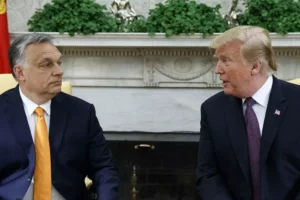I would like to point out the essential difference, i.e. the erroneous meaning of “Westernisation” here in the West as opposed to the historical West. Here “Westernisation” means only the exaltation of technocracy, markets and trade in the liberal-bourgeois meaning of the word, as well as the annulment of the concept of independent politics with the homogenisation of parties and ideas to a single way of thinking. By now, parties are no longer distinguished by their ideological power, but by the media power of their leaders: they are like football teams that have a very strong player, but if the latter is bought by another club, the relations are reversed. After all, the history of Italian politics is full of turncoats.
This presupposes the attempt to annihilate every metaphysical value that is linked to political, religious, national and humanitarian ideals: in other words, considering man, or the event, only as a function of profit, of money, of the gain of a few compared to a mass that is desired to be amorphous, deprived of feelings and homogenised to the capitalist system of production. But let us see how Westernisation – which is quite different from the West understood in the historical sense, and from modernisation considered in the literal sense – has come about and developed.
When at the beginning of the 20th century the United States of America under President Thomas Woodrow Wilson (1913-1921) claimed to act in favour of freedom of the seas and the democratisation of European governments, it was actually using those slogans to secure economic penetration into continental Europe, as had already happened in Latin America. The US demand was therefore for a world in which access to markets and investment was possible: in other words, an eminently imperialistic policy, concealed by the pretext of having no colonies, while – compared to the original Thirteen Stars of New England – the United States of America had already swallowed up 75 per cent of Mexican territory and bought up French (Louisiana) and Russian (Alaska) non-European regions at a good price. It was by no mere coincidence that Wilson had leveraged on the Monroe Doctrine for its function of expansion without space limits defined by borders.
In other words, it was necessary to upset international law, which at the time was nothing more than European public law. It encompassed the concert of States – reaffirmed by the Congress of Vienna in 1815 – which, despite constant clashes in the 1820-1870 period, had protected countries from the emergence of a single power. A law already based on the territorial conquests of the 16th and 17th centuries and heir to Westphalia. Moreover, the colonial experience of the 19th century would undermine the European order. European and international public law traditionally recognised that private property and market control would remain protected in any transfer of territory between its States. The territorial changes in the West as historically understood – the three partitions of Poland (1772, 1793, 1795), the birth of Italy (1861) and Germany (1871) and the subsequent annexation of Alsace-Lorraine in addition to the previous wars – did not lead to radical changes in the European social and economic order.
The subsequent race for colonies, however, was set in an arena in which the property rights of indigenous peoples and their political claims were defined as non-existent. As long as – from a conceptual viewpoint – colonial land had been kept separate from “normal state territory”, Europe had encountered no problems; but when colonial land – with its absence of a private property status that could protect the natives’ rights – was legally assimilated to the territory of the motherland, “the structure of hitherto existing European international law also changed, which thus came to an end” – said Carl Schmitt, to the detriment of the European colony owners themselves. Europe “believed in the most candid manner that the process of enlargement that was becoming ever more extensive, ever more external and ever more superficial was a victory”. In reality, there was a translation, a shift of the Old Continent: from the centre of the earth, in international law, this was mistaken for an elevation of Europe to central point of the world. By undermining the traditional immunities of private property relations from transfers of territory, colonial annexations had weakened territorial pluralism and property rights within European States.
We cannot but agree with Carl Schmitt when he wrote in The Nomos of the Earth in the International Law of the Jus Publicum Europaeum (1950) that the trivialisation of European territoriality was only paving the way for the triumph of the Anglo-American campaign to impose an empire of economic globalisation. Schmitt added: “With this abdication of international law, Europe [at the time, as mentioned above, the sole and historical West] faltered into a world war [the first one in 1914-1918] that deprived the oldest continent of its position as the centre of the earth and annulled the hitherto successful limitation of war”. The Brits and the Americans therefore imposed a commercial or market universalism based on the control of the seas, as did the democratic decoy called the League of Nations, wanted by Wilson, that however the United States of America never joined, as there were Latin American countries that took part in its stead. We should not forget also the mother of the League of Nations, namely the Paris Peace Conference of 1919, which represented the first triumph of the new principles. But not only did it leave the world in greater disarray by abolishing four great European powers (Austria-Hungary, Germany, Russia and also the Eurasian Ottoman Empire); by initiating a new division of European territory, and giving birth – with its oppressive measures – to the incipient Nazism, the seed of the coming World War II with the new US intervention alongside a Britain that had always been anti-European and on the wane, but to which the White House gave nothing away by making it pay for everything.
After the Second World War, the Western hemisphere represented a new amorphous space structure, exactly like those that naive Europeans had agreed upon when dividing up land during the colonial era. From colonialists they became colonised with a single border separating the countries controlled by NATO and the others by the Warsaw Pact (with the exceptions of Albania and, less radically, Romania). The European West became the retainer of the protector, that defended it from the bad guys, but with salary and control of markets, production system and domestic policies.
The New West, i.e. the United States of America, had eradicated Europe – the Old West – from its metaphysical-historical location, removing it as the centre of the world. The West, with all that the concept implies morally, civilly and politically, was not eliminated or annihilated, nor even dethroned, but merely displaced, thus creating “Westernisation”, which has nothing to do with the West and its spiritual and historical traditions.















